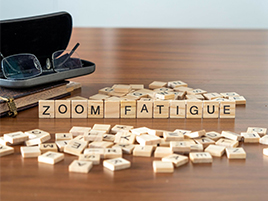
Many families and workplaces are continuing to rely on virtual meetings or family webcam hangouts. This kind of social interaction can be mentally tiring, so it’s important to alleviate stress to keep that fatigue at bay. Here are a few tips.
Ground Yourself Before Video Conferencing Meetings
Grounding yourself can mean breathing deeply, listing things you can see, feel, and hear, or even holding on to something cold and heavy. Grounding won’t remove all your stress, but it can remove some of it, which counts as a win.
Take Breaks Between Calls
If at all possible, schedule breaks between calls. Wall-to-wall calls aren’t good in the long term.
Advocate for Yourself When You Feel Fatigued
If you’re in too many meetings, where you don’t really have much to contribute or learn, if all you do is attend video meetings, then it’s time to speak up. Ask to reduce your video meeting workload or for some video meetings to no longer be video meetings.
Make Video Conferencing Easier
Try using speaker view instead of gallery view so you can look at one person at a time. This might be less visually draining than seeing a whole bunch of people at once.
You can also try turning off your camera. This might reduce your stress if you get agitated by being on camera in front of a lot of people.
You can put a virtual background on your conference calls. Zoom provides the option to choose any background you’d like to display behind you. Experiment with a few until you find one you like.
Invest Time in Learning to Read Facial Expressions
There are lots of online courses about reading facial expressions from an artistic, psychological, or business perspective. Teaching yourself this skill might reduce your anxiety on video calls.
Familiarize Yourself with the Agenda
The agenda will help you prepare what is necessary, keep on task during the meeting, and keep the meeting short.
Be Neatly Dressed
Aside from looking good, being neatly dressed will put you in the right headspace for a meeting.
Preview Your Appearance
Video call yourself using more than one device to see what you look and sound like. You can use filters, adjust your microphone, or invest in better equipment to make you look your best. Practice your setup in advance so you see what others will see.
Don’t Watch Yourself
It’s better to watch other meeting attendees than yourself, as it’s easy to focus on what you look like instead of what others are saying. This may be easier said than done, but you can use the ‘hide self-view’ functionality or turn on speaker view instead of gallery view, allowing you to focus on one person at a time.
Learn Your Software
Look up a quick course online or consult with an IT person about the software you’re using. Don’t just master the basics; learn all the tools you have at your disposal.
Minimize Distractions
Turn off your notifications. Even better, put your phone on silent or airplane mode. On your computer, turn off applications that are bound to distract you, like your web browser, email client, or games.
Try Headphones
Headphones (or noise-cancelling earbuds) can help reduce distractions and ambient noises when you’re on a call.
Final Thoughts
Video fatigue exists, and it must be addressed to improve workplace communication. Consider using email or instant messaging features like Microsoft Teams Chat or Slack, to complete tasks if you are in a position where you have the authority to manage video-related stress and fatigue.

